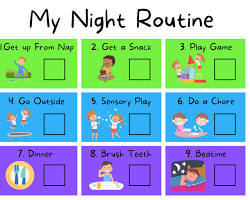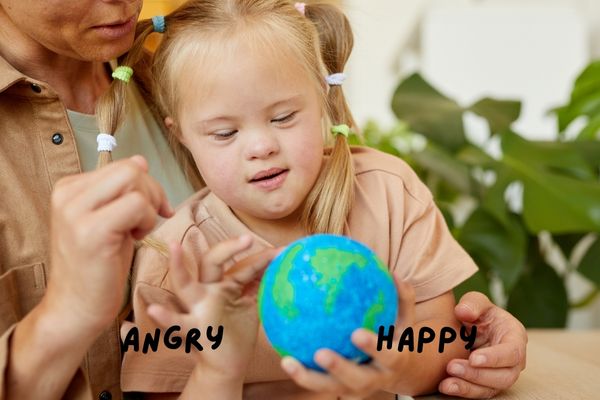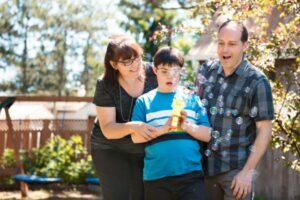Teaching a child with autism at home can be a rewarding experience, but it can also be challenging. Children with autism learn differently than neurotypical children, so it is important to use teaching methods and strategies that are tailored to their individual needs.
In this article, we will discuss different teaching methods and strategies that can be used to teach children with autism at home. We will also provide autism homeschooling tips to help you get started.
Teaching methods and strategies for children with autism
Some of the most effective teaching methods and strategies for children with autism include:
-
Visual supports
Visual supports are visual representations of information, such as pictures, symbols, and schedules. They can be used to help children with autism understand and follow instructions, communicate their needs, and learn new skills.
Visual supports can be used in a variety of ways, such as:
-
- To create a daily schedule. A daily schedule can help children with autism know what to expect throughout the day. It can also help them to transition from one activity to another.
- To give instructions. Visual instructions can help children with autism understand and follow complex instructions. For example, you could use a picture of a step-by-step process to show a child how to tie their shoes.
- To communicate. Children with autism who have difficulty speaking can use visual supports to communicate their needs and wants. For example, a child could use a picture of a snack to indicate that they are hungry.
- To learn new skills. Visual supports can be used to teach children with autism new skills, such as reading, writing, and math. For example, you could use flashcards with pictures and words to teach a child to read.
Here are some examples of visual supports that can be used to teach children with autism:
-
Picture schedules:

Picture schedule for children with autism Picture schedules are a simple and effective way to help children with autism understand and follow a daily routine. To create a picture schedule, simply take pictures of the different activities that your child will participate in throughout the day and put them in order. You can then post the picture schedule in a place where your child can see it easily.
-
Social stories:

Social story for children with autism Social stories are short stories that describe social situations and how to behave in those situations. Social stories can be helpful for children with autism who have difficulty understanding social cues and interacting with others. To create a social story, simply think about a social situation that your child is struggling with and write a story about how to handle that situation. You can then use pictures to illustrate the story.
-
Visual cues:

Visual cues for children with autism Visual cues are visual representations of instructions or information. For example, you could use a red light-green light system to help a child with autism understand when it is okay to talk and when it is not. You could also use a picture of a hand to help a child understand to raise their hand before speaking.
-
Assistive technology:

Assistive technology for children with autism Assistive technology can be used to provide children with autism with access to visual supports. For example, a child could use a tablet or computer to access a visual communication app or a digital picture schedule.
-
-
Applied behavior analysis (ABA)
Applied behavior analysis (ABA) is a therapy approach that focuses on teaching children new skills and behaviors by breaking them down into smaller steps. ABA is based on the principle that behavior is influenced by its consequences. Therefore, ABA therapists use positive reinforcement, such as praise or stickers, to reward children for desired behaviors.
ABA can be used to teach children with autism a wide range of skills, including:
- Communication skills, such as how to request and respond to requests
- Social skills, such as how to make eye contact and take turns in conversation
- Self-care skills, such as how to dress and eat independently
- Academic skills, such as reading, writing, and math
ABA can be delivered in a variety of settings, including homes, schools, and clinics. ABA sessions are typically one-on-one and last for 30-60 minutes.
Here are some examples of how ABA can be used to teach children with autism:
-
Teaching a child to communicate:
An ABA therapist might start by teaching a child to request a desired item, such as a snack or a toy. The therapist would use positive reinforcement to reward the child for requesting the item. Once the child is able to request the item consistently, the therapist can start teaching the child to respond to requests. For example, the therapist might ask the child to point to a desired item or to say the word for the item.
-
Teaching a child social skills:
An ABA therapist might teach a child social skills by role-playing different social situations. For example, the therapist might role-play how to make eye contact, how to take turns in conversation, and how to share toys. The therapist would use positive reinforcement to reward the child for using social skills appropriately.
-
Teaching a child self-care skills:
An ABA therapist might teach a child self-care skills by breaking them down into smaller steps. For example, to teach a child how to dress independently, the therapist might start by teaching the child how to put on a sock. Once the child is able to put on a sock consistently, the therapist can start teaching the child how to put on a shirt and pants.
-
Teaching a child academic skills:
An ABA therapist might teach a child academic skills by using a variety of teaching methods, such as direct instruction, visual supports, and positive reinforcement. The therapist would tailor the teaching methods to the child’s individual needs and learning style.
ABA can be an effective way to teach children with autism new skills and behaviors. However, it is important to note that ABA is not a cure for autism. ABA can help children with autism to learn and thrive, but it does not change the underlying neurological differences associated with autism.
If you are considering ABA therapy for your child with autism, it is important to do your research and find a qualified therapist. You should also be aware that ABA therapy can be expensive and time-consuming.
-
Discrete trial training (DTT)
Discrete trial training (DTT) is a type of applied behavior analysis (ABA) that involves breaking down skills into very small steps and then teaching each step one at a time. During a DTT session, the therapist will present the child with a stimulus (e.g., a picture of a ball) and ask the child to perform a target behavior (e.g., say the word “ball”). If the child performs the target behavior correctly, the therapist will provide positive reinforcement (e.g., praise or a sticker). If the child does not perform the target behavior correctly, the therapist will prompt the child and try again.
DTT is a highly effective teaching method for children with autism. It is especially beneficial for children who have difficulty learning new skills and who need a lot of repetition. DTT can be used to teach children with autism a wide range of skills, including communication skills, social skills, self-care skills, and academic skills.
Here is an example of how DTT can be used to teach a child with autism to say the word “ball”:
- The therapist will present the child with a picture of a ball and say the word “ball” in a clear voice.
- The therapist will wait for the child to say the word “ball”.
- If the child says the word “ball” correctly, the therapist will provide positive reinforcement (e.g., praise or a sticker).
- If the child does not say the word “ball” correctly, the therapist will prompt the child and try again.
- The therapist will repeat this process until the child is able to say the word “ball” correctly on a consistent basis.
DTT can be a challenging teaching method for both the therapist and the child. However, it is an effective way to teach children with autism new skills. DTT is often used in conjunction with other teaching methods, such as visual supports and positive reinforcement.
Here are some of the benefits of using DTT to teach children with autism:
- DTT is a highly effective teaching method. It is especially beneficial for children who have difficulty learning new skills and who need a lot of repetition.
- DTT can be used to teach children with autism a wide range of skills, including communication skills, social skills, self-care skills, and academic skills.
- DTT is a structured and predictable teaching method. This can be helpful for children with autism who thrive on routine and predictability.
- DTT provides children with autism with immediate feedback on their performance. This can help children to learn and improve more quickly.
However, there are also some potential challenges to using DTT to teach children with autism:
- DTT can be a time-consuming and challenging teaching method for both the therapist and the child.
- DTT can be repetitive and boring for some children.
- DTT can be difficult to use in natural settings.
- DTT does not always generalize to other settings or situations.
If you are considering using DTT to teach your child with autism, it is important to talk to your child’s doctor or therapist. They can help you to decide if DTT is the right teaching method for your child and can teach you how to use DTT effectively.
-
Pivotal response training (PRT)
Pivotal response training (PRT) is a type of applied behavior analysis (ABA) that focuses on teaching children skills that will help them communicate and interact with others. PRT is based on the principle that communication is essential for social learning and development. Therefore, PRT therapists focus on teaching children how to initiate and respond to communication.
PRT can be used to teach children with autism a variety of communication skills, including:
- Joint attention: Joint attention is the ability to share focus with someone else on an object or event. PRT therapists teach children joint attention by following the child’s gaze and pointing to the object or event that the child is interested in.
- Imitation: Imitation is the ability to copy the behavior of another person. PRT therapists teach children imitation by demonstrating a behavior and then waiting for the child to imitate the behavior.
- Turn-taking: Turn-taking is the ability to wait for one’s turn in a conversation or activity. PRT therapists teach children turn-taking by playing games and activities that require turn-taking.
- Requesting: Requesting is the ability to ask for what one wants. PRT therapists teach children requesting by modeling requesting behavior and by providing positive reinforcement when the child requests something.
PRT is typically delivered in one-on-one sessions that last for 30-60 minutes. PRT sessions can take place in a variety of settings, including homes, schools, and clinics.
Here is an example of how PRT can be used to teach a child with autism to request a snack:
- The child is sitting at a table with a PRT therapist.
- The PRT therapist places a snack on the table, out of the child’s reach.
- The PRT therapist makes eye contact with the child and says, “Snack.”
- The PRT therapist waits for the child to request the snack.
- If the child requests the snack (e.g., by saying “snack” or by pointing to the snack), the PRT therapist provides positive reinforcement (e.g., praise or a small toy).
- If the child does not request the snack, the PRT therapist prompts the child by saying, “Say ‘snack.'”
- The PRT therapist repeats this process until the child is able to request the snack on a consistent basis.
PRT is an effective way to teach children with autism communication skills. PRT can also help children with autism to develop social skills and to learn other important skills, such as academic skills.
Here are some of the benefits of using PRT to teach children with autism:
- PRT is a highly effective way to teach children with autism communication skills.
- PRT is a relatively easy-to-learn teaching method.
- PRT can be used to teach children with autism a variety of communication skills, including joint attention, imitation, turn-taking, and requesting.
- PRT can be used in a variety of settings, including homes, schools, and clinics.
However, there are also some potential challenges to using PRT to teach children with autism:- PRT can be time-consuming and challenging for both the therapist and the child.
- PRT requires a high level of motivation from the child.
- PRT may not be effective for all children with autism.
If you are considering using PRT to teach your child with autism, it is important to talk to your child’s doctor or therapist. They can help you to decide if PRT is the right teaching method for your child and can teach you how to use PRT effectively.
- Natural environment training (NET)
Natural environment training (NET) is a type of applied behavior analysis (ABA) that involves teaching children skills in the natural environment, such as at home or in the community. NET is based on the principle that it is important for children to learn skills in the context in which they will be used.
NET can be used to teach children with autism a wide range of skills, including:
- Communication skills: NET therapists can teach children communication skills in the context of everyday activities. For example, a therapist might teach a child to request a snack at the grocery store or to say goodbye to a friend at the park.
- Social skills: NET therapists can teach children social skills in the context of social interactions. For example, a therapist might teach a child how to make eye contact, how to take turns in conversation, and how to share toys with other children.
- Self-care skills: NET therapists can teach children self-care skills in the context of everyday routines. For example, a therapist might teach a child how to dress independently, how to eat with a fork and spoon, and how to brush their teeth.
- Academic skills: NET therapists can teach children academic skills in the context of natural learning opportunities. For example, a therapist might teach a child to count the number of steps on a staircase or to identify different types of animals at the zoo.
NET is typically delivered in one-on-one sessions, but it can also be delivered in small groups. NET sessions can take place in a variety of settings, including homes, schools, and community centers.
Here is an example of how NET can be used to teach a child with autism to request a snack at the grocery store:
- The child and NET therapist are at the grocery store.
- The child sees a box of cookies that they want.
- The therapist prompts the child to request the snack by saying, “What do you want?“
- The child says, “Cookies.“
- The therapist praises the child and then helps the child to get the cookies.
The therapist repeats this process in a variety of different settings until the child is able to request snacks independently.
NET is an effective way to teach children with autism skills in the natural environment. NET can help children to learn and generalize skills to new settings and situations.
Here are some of the benefits of using NET to teach children with autism:
- NET is a highly effective way to teach children with autism skills in the natural environment.
- NET can help children to learn and generalize skills to new settings and situations.
- NET is a motivating teaching method for children.
- NET is a family-friendly teaching method.
However, there are also some potential challenges to using NET to teach children with autism:
- NET can be time-consuming and challenging for the therapist.
- NET requires a high level of motivation from the child.
- NET may not be effective for all children with autism.
If you are considering using NET to teach your child with autism, it is important to talk to your child’s doctor or therapist. They can help you to decide if NET is the right teaching method for your child and can teach you how to use NET effectively.
Autism homeschooling tips
Here are some autism homeschooling tips to help you get started:
-
Create a structured and predictable environment.
Children with autism thrive on routine and predictability. Create a daily schedule for your child and stick to it as much as possible.
-
Use visual supports.
Use pictures, symbols, and schedules to help your child understand and follow instructions.
-
Break down tasks into smaller steps.
Children with autism may have difficulty understanding and completing complex tasks. Break down tasks into smaller steps and teach each step one at a time.
-
Provide positive reinforcement.
Children with autism are more likely to learn and repeat behaviors that are reinforced. Provide positive reinforcement, such as praise or stickers, when your child follows instructions or completes a task.
-
Be patient and flexible.
Learning takes time and effort, especially for children with autism. Be patient with your child and be flexible in your approach.
Additional tips
Here are some additional tips for teaching children with autism at home:
-
Get to know your child’s individual needs.
What are their interests? What are their strengths and weaknesses? What kind of learning style do they have? The more you know about your child, the better equipped you will be to teach them.
-
Collaborate with other professionals.
If your child is receiving services from other professionals, such as a speech therapist or occupational therapist, collaborate with them to develop a comprehensive teaching plan.
-
Take breaks.
Homeschooling can be challenging for both parents and children. It is important to take breaks when you need them. Go for a walk, read a book, or listen to some music. Taking breaks will help you to stay refreshed and focused.
Conclusion
Teaching a child with autism at home can be a rewarding experience, but it can also be challenging. By using the teaching methods and strategies discussed in this article, and by following the autism homeschooling tips, you can help your child to learn and thrive.
FAQ about Autism Homeschooling Tips
Q: What are some of the benefits of homeschooling a child with autism?
A: There are many benefits to homeschooling a child with autism, including:
- Personalized learning: Homeschooling allows you to tailor the curriculum to your child’s individual needs and learning style. This is especially important for children with autism, who may not thrive in a traditional public school setting.
- One-on-one attention: In a homeschooling setting, your child will receive more one-on-one attention from you. This allows you to provide them with the support and encouragement they need to succeed.
- Structured and predictable environment: Children with autism thrive on routine and predictability. You can create a structured and predictable environment for your child at home.
- Reduced stress and anxiety: Homeschooling can reduce stress and anxiety for children with autism. They will not have to worry about being bullied or teased, and they will not have to deal with the sensory overload that can occur in a traditional school setting.
Q: What are some challenges of homeschooling a child with autism?
A: Some of the challenges of homeschooling a child with autism include:
- Time and effort: Homeschooling requires a lot of time and effort from parents. You will need to plan lessons, teach your child, and provide them with support and encouragement.
- Learning new skills and strategies: You may need to learn new skills and strategies for teaching a child with autism. This may involve researching different teaching methods, adapting curriculum materials, and using assistive technology.
- Socialization: Homeschooling children with autism may have fewer opportunities to socialize with other children. It is important to make an effort to provide your child with opportunities to interact with other children, such as through homeschooling co-ops, extracurricular activities, and community events.
Q: What are some autism homeschooling tips?
A: Here are some autism homeschooling tips:
- Create a structured and predictable environment. Children with autism thrive on routine and predictability. Create a daily schedule for your child and stick to it as much as possible.
- Use visual supports. Visual supports, such as pictures, symbols, and schedules, can help children with autism understand and follow instructions.
- Break down tasks into smaller steps. Children with autism may have difficulty understanding and completing complex tasks. Break down tasks into smaller steps and teach each step one at a time.
- Provide positive reinforcement. Children with autism are more likely to learn and repeat behaviors that are reinforced. Provide positive reinforcement, such as praise or stickers, when your child follows instructions or completes a task.
- Be patient and flexible. Learning takes time and effort, especially for children with autism. Be patient with your child and be flexible in your approach.
Q: Where can I find more information about autism homeschooling?
A: There are many resources available to help you with autism homeschooling. Here are a few suggestions:
- Online and in-person homeschooling support groups: These groups can provide you with support and advice from other homeschooling families, including families with children with autism.
- Homeschooling curriculum companies: Many homeschooling curriculum companies offer specialized curriculum for children with autism.
- Assistive technology companies: Assistive technology companies offer a variety of products and services to help children with autism learn and thrive.
- Government programs: The government offers a number of programs to help families with special needs children, including homeschooling programs.
I hope this FAQ has been helpful. If you have any other questions, please feel free to leave a comment below.






Be First to Comment